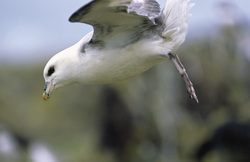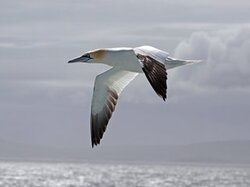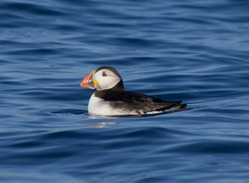Seabird profiles
At the time of the last comprehensive survey of breeding seabirds in Scilly (2006), there were fourteen breeding species. This section provides some introductory information to these species, which are in five groups. The gannet is also included as it can be seen year-round in Scilly, and roseate tern is included as a former breeder.
Petrels
Manx shearwaterSummer visitor. 171 pairs in 2006, 523 in 2015. The middle-sized of our three nesting petrels, very slightly heavier than a puffin. This is a key species for the Seabird Recovery Project. Structurally more similar to a fulmar than a storm petrel, with long wings held straight and with stiff, flapping flight interspersed with glides. Black above and white below creates a very striking appearance when seen well. Frequently, small groups are found sitting on the sea (‘rafts’), with larger congregations of up to several hundred in the evening before birds return to their nests after dark. Manx shearwaters fly in broken lines low to the water, occasional birds breaking the horizon. In windy weather there is very little flapping involved, as birds shear through the air and between wave troughs, rising higher above the horizon. Feeds mostly on small fish and squid from the surface and by diving, and will also take small crustaceans and offal. A distinctive feature is the remarkable wailing call given in the evening and at night. There is only one other colony of Manx shearwater in England, on Lundy Island in the Bristol Channel. A similar island restoration was carried out there ten years ago and seabird numbers have boomed as a result. Number of eggs: 1 Typical lifespan: 15 years Oldest known bird in UK: 50 years 11 months (originally caught as a breeding adult, so at least 55 years old). |
|
|
Storm petrel(European storm petrel) Summer visitor. 1398 pairs in 2006, 1299 in 2015 A tiny seabird, rarely seen near land during the day. Nests among boulders and in crevices, returning to the nests only after dark. All dark, but with a bold white rump and white bar under the wing. Like the fulmar and Manx shearwater, it is a member of the ‘tubenose’ family that includes the albatrosses. At sea, a fluttering, 'bat-like' flight close to the water and occasionally foot-patters on the surface with wings raised. They feed from the surface of the sea, eating surface plankton and small fish. Like the Manx shearwater, this is another accomplished yet bizarre vocalist, with a delightful purring heard from birds at the nest. Scilly is the only breeding colony of this species in England, which represents about 5% of the UK population. It is of international significance. Number of eggs: 1 Typical lifespan: 11 years Oldest known bird in UK: 31 years 11 months |
|
|
Fulmar(Northern fulmar) Resident. 279 pairs in 2006, 286 in 2015. The largest of our three nesting petrels. Rather gull-like, with a conspicuous white head and ‘bull neck’, but unlike gulls flies on straight wings with patterns of very stiff wing beats and glides. Close up, shows the distinctive ‘tubenose’ bill, and dark eye fringed with dark feathers gives gentle expression. Famed for its ability to spew a noxious vomit when threatened, but this is the oil-rich ‘fuel’ they use for foraging trips so avoid disturbance. Soiled clothes can never be cleaned! Nests on rocky coasts on ledges, often visting these during the winter. Pairs frequently rest facing one another and birds make a guttural cackling. A long-lived seabird, not starting to breed until nine years of age. Feeds on crustaceans, squid, fish and offal, mostly from the surface. Very commonly attends fishing boats. Number of eggs: 1 Typical lifespan: 44 years Oldest known bird in UK: 40 years 10 months |
|
Larger seabirds
ShagResident. 1296 pairs in 2006, 1010 in 2015. The commonest resident seabird in Scilly, representing the third largest colony in Britain. The shag is smaller than the larger, stockier Cormorant. It is further distinguished from that species by the uniform dark bottle-green plumage with just a thin yellow strip around the base of the bill. The neck is much slimmer and the head small and rounded. In spring, there is a distinctive crest or ‘quiff’ on the head, although as summer draws on this largely wears away. Shags are often seen in large groups in Scilly, packed side by side on the uninhabited islands and rocks. One behaviour you may see is their flocking behaviour on the water. These ‘rafts’ are believed linked to foraging behaviour. Like cormorants, shags catch fish by diving from the water surface, often with a little ‘jump’ not seen from cormorants. Number of eggs: 3 Typical lifespan: 12 years Oldest known bird in UK: 29 years 10 months |
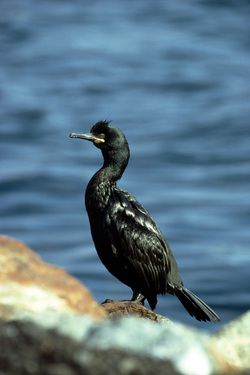 Chris Gomersall ©rspb-images.com |
|
Cormorant(Great cormorant) Resident. 50 pairs in 2006, 30 in 2015. Our largest nesting seabird, with males weighing about 2.5kg. Looks black, but subtle shades of green, blue and violet can be seen in a close view. Rather reptilian shape, sharing with shag the habit of sitting on rocks with its wings spread, as if to dry. Told from the similar shag by larger size, with a thick neck and heavy, wedge-shaped head and bill. Like the shag, feeds by diving from the water surface to catch fish, but never seen here in large groups. In summer, adults have a large white patch on the thigh and a white chin. The earliest nesting of our seabirds. Nests are on the ground on rocks and often among vegetation. Number of eggs: 3-4 Typical lifespan: 11 years Oldest known bird in UK: 23 years 6 months |
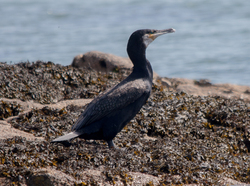 Cormorant@Will Wagstaff |
|
Gannet(Northern gannet) Non-breeding visitor, all year. The UK’s largest nesting seabird, with a long, cigar-shaped body and spear-like bill. The wingspan is 1.75m (5½ feet). The nearest breeding colonies are in Wales and the Channel Isles, and it is thought that most of the birds visiting Scilly are from Wales. Adults, with their gleaming white plumage and black wing tips, can be seen all year. Younger birds tend to be seen from early summer until late autumn. A spectacular seabird. Dives for fish under water from a height of 20m or more, entering the water at over 90km/hr. Feeding gannets are often a clue to check the water surface for dolphins! Number of eggs: 1 Typical lifespan: 17 years Oldest known bird in UK: 37 years 4 months |
|
Auks
Puffin(Atlantic puffin) Summer visitor. 174 pairs in 2006, 167 in 2015. The puffin is probably the most popular seabird in Scilly! This is the smallest and most colourful of the three auks nesting in Scilly. They return later than razorbills and guillemots, usually in late April or early May, leaving by August. The remarkable coloured bill is why the name ‘sea parrot’ arose. The white cheeks surrounded by black are also very different to the other auks, as are the bright orange legs and feet. Puffins are only the height of a milk bottle, and tend to nest in burrows and crevices. The upperparts are black, and in flight wings have no white edge of the rear, distinguishing them from the larger auks even when the head and bill can’t be seen. In fact, the all dark wings more resemble those of Manx shearwater, although the whirring flight is very different. Like razorbills, puffins carry food across the bill, usually carrying several fish at a time. Number of eggs: 1 Typical lifespan: 18 years Oldest known bird in UK: 35 years 11 months |
|
|
RazorbillSummer visitor. 342 pairs in 2006, 471 in 2015. The stockiest and most common of the three auks nesting in Scilly. This is the species most likely to be seen between the islands and in winter. The upperparts are black, and the bill is thick and chunky with a thin, white, vertical stripe. There is also a lovely narrow white ‘eyebrow’ between the bill and the eye, which gives a most characterful expression. They nest on ledges and in crevices, and like the other auks are very much dependent on fish for food, although they will also take marine invertebrates. The narrow wings and powerful breast muscles help them hunt fish underwater and sand eels are a very popular prey. Number of eggs: 1 Typical lifespan: 13 years Oldest known bird in UK: 41 years 11 months |
|
|
Guillemot(Common guillemot) Summer visitor. 155 pairs in 2006, 291 in 2015. The scarcest of the three auks nesting in Scilly. The upperparts are a warm brown and the bill is long and dagger-shaped. Like the razorbill and puffin, flies with narrow, rapidly flapping wings usually low over the water. Dives down up to 60m for food, mostly fish. Nests on narrow ledges with ‘territories’ just 10cm across, and the egg is designed to roll in tight circles. Can fly long distances to find food, and usually returns to the nest with a single fish held along, not across the bill. Number of eggs: 1 Typical lifespan: 23 years Oldest known bird in UK: 32 years 2 months |
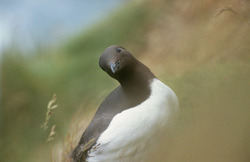 Andy Hay ©rspb-images.com |
Gulls
Kittiwake(Black-legged kittiwake) Summer visitor. 266 pairs in 2006, 75 in 2015. Conservation status in UK = AMBER The smallest and most beautiful of our regular breeding gulls, but with fewer than 80 pairs in 2012. This is the true ‘seagull’, as it spends nearly all its life at sea, return to the nesting cliffs in March and leaving in August. At the nest, the evocative call that gives them their name can be heard. The upperparts and wings are a pearly grey with a translucent aspect to the wings. The wing tips are solid black, often described as ‘dipped in ink’. The flight is buoyant and graceful, at a distance resembling a tern. This comparison strengthened by the kittiwake’s habit of feeding from the sea surface, where it takes marine invertebrates and fish. The chicks are covered in pure white down, and the fledged young have a crisp and complex black, grey and white pattern completely unlike the other gulls. Number of eggs: 2 Typical lifespan: 20 years Oldest known bird in UK: 28 years 6 months |
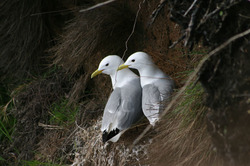 |
|
Herring gullResident. 715 pairs in 2006, 574 in 2015. Conservation status in UK = RED This familiar bird with its silver grey upperparts is what most people think of as a ‘seagull’. It is hard to believe that of the nesting seabirds currently in Scilly, this has the highest conservation status! This is because of the distinct nature of the NW European population (subspecies argenteus), and a recent big decline in numbers. A similar size to the lesser black-backed gull, but much paler grey above and with pink legs. A small number nest on buildings in Scilly, but most nest on rocky shores. Number of eggs: 3 Typical lifespan: 12 years Oldest known bird in UK: 30 years 11 months |
 |
|
Lesser black-backed gullSummer visitor. 3335 pairs in 2006. 2531 in 2015. The commonest of our nesting gulls, and the numbers in Scilly are of international importance owing to the distinct nature of the NW European population (subspecies graellsii) petrels. A migratory species, rather than an ocean wanderer like the kittiwake, they start to return in February, leaving again by October. Birds winter as far south as west Africa. Lesser black-backed gulls are slimmer and longer-winged than herring gull and noticeably smaller than great black-backed gull, with medium-grey upperparts and wings (shading darker near the tips) and with yellow legs. Number of eggs: 3 Typical lifespan: 15 years Oldest known bird in UK: 34 years 10 months |
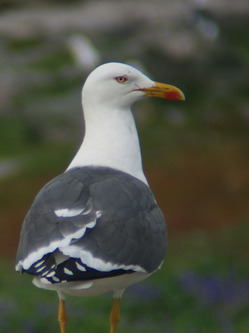 |
|
Great black-backed GullResident. 901 pairs in 2006, 1023 in 2015. The gull whose scientific name (‘marinus’) actually does mean, ‘sea gull’! The numbers in Scilly are of national importance. This is our biggest gull, with a very heavy set head and body, weighing half as much again as a herring gull, and a deep call to match. The back and wings are black, the legs flesh coloured and the bill yellow with a red dot. This is our ‘top predator’ in Scilly and one of the reasons why storm petrels and Manx shearwaters only arrive at the nest after dark. They are omnivorous and opportunistic. They mainly eat animals up to the size of rabbits, including other seabirds, and offal, frequently scavenging or pirating food from others. Number of eggs: 2-3 Typical lifespan: no data Oldest known bird in UK: 24 years 11 months |
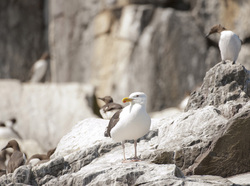 Kaleel Zibe ©rspb-images.com |
Terns
Common ternSummer visitor. 78 pairs in 2006, 12 in 2015. The ‘sea swallow’. A declining breeding bird in Scilly with no successful breeding in the past four years. Smaller and more graceful than Sandwich tern, with long tail streamers. The back is grey and the black cap is not shaggy. The bill is orange red with a black tip and the legs are red. Like other terns, nests on the ground, often on rocky islands, beaches or heathland. They dive for food, which is mostly fish. Number of eggs: 2-3 Typical lifespan: 12 years Oldest known bird in UK: 33 years 0 months |
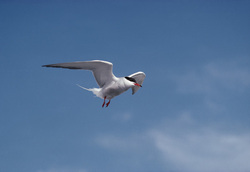 Chris Gomersall ©rspb-images.com |
|
Sandwich ternSummer visitor. Occasional breeder in Scilly. The UK’s largest nesting tern species and one of the earliest migrants to appear in spring. The shaggy black cap is distinctive, and the black bill with a yellow tip is diagnostic. The legs are black. Sandwich terns are whiter than common terns and very vocal, with a raucous ‘eric’ call. They feed on fish by diving into the water. Spring migration through Scilly is usually light, and autumn migration lasts from July to October, when large numbers may be present. Number of eggs: 1-2 Typical lifespan: 12 years Oldest known bird in UK: 30 years 9 months |
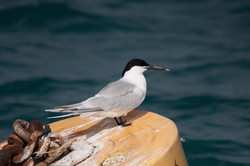 Sandwich tern@Will Wagstaff |
|
Roseate ternSummer visitor. Former breeder. Last bred in 1994. Our rarest breeding tern and previously the subject of its own Species Recovery Project. This is a very pale tern similar to common tern but with very long tail streamers and a black bill that becomes deep red by late summer. Number of eggs: 1-2 Typical lifespan: 8 years Oldest known bird in UK: 23 years 10 months |
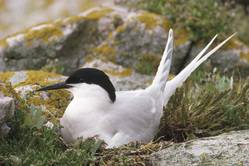 Chris Gomersall ©rspb-images.com |





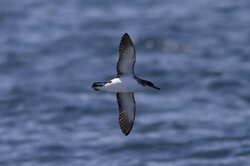
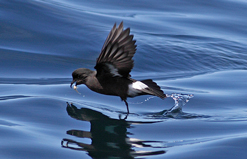 ©Joe Pender
©Joe Pender